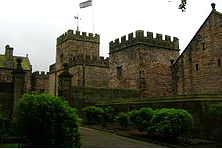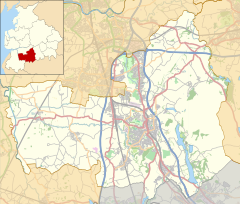Hoghton Tower
| Hoghton Tower | |
|---|---|
 |
|
| Location | Hoghton, Lancashire, England |
| Coordinates | 53°43′58″N 2°34′25″W / 53.7329°N 2.5735°WCoordinates: 53°43′58″N 2°34′25″W / 53.7329°N 2.5735°W |
| OS grid reference | SD 623,264 |
| Elevation | 560 ft (170 m) |
| Built | c, 1560–65 |
| Built for | Thomas de Hoghton |
| Restored | 1862–1902 |
| Restored by |
Sir Henry de Hoghton Sir Charles de Hoghton |
| Architect |
Paley and Austin, James Bertwistle, Robert Dudley Oliver |
|
Listed Building – Grade I
|
|
| Designated | 22 October 1952 |
| Reference no. | 1072532 |
Hoghton Tower is a fortified manor house located about 0.7 miles (1 km) to the east of the village of Hoghton, Lancashire, England, and standing on a hilltop site on the highest point in the area. It takes its name from the de Hoghton family, its historical owners since at least the 12th century. The present house dates from about 1560–65. It was damaged during the Civil War and subsequently became derelict, but was rebuilt and extended between 1862 and 1901. The house is listed at Grade I, as is the Great Barn in its grounds, which is dated 1692. Also in the grounds are two structures listed at Grade II. The house and garden are open to the public at advertised times, and are administered by a charitable trust.
The land on which the house stands has been in the possession of the de Hoghton family from at least the 12th century. The present building dates from about 1560–65, and was built for Thomas de Hoghton, replacing an earlier house on or near the same site. It has been suggested that the property has links to William Shakespeare through Alexander Hoghton who died in 1581.
King James I stayed in the house for three days in 1617. In 1643 the house was damaged by Parliamentary forces during the Civil War, and in 1692–1702 Sir Charles de Hoghton carried out repairs and rebuilding. The family ceased to live in the house from 1768, and it was rented to local farmers. It was derelict by the middle of the 19th century.Sir Henry de Hoghton, the 9th Baronet, inherited the estate in 1862 and decided to restore the house. It is not known who carried out the earlier part of the restoration, but by 1876 the Lancaster architects Paley and Austin were involved, having carried out work on rooms including the banqueting hall. Sir Henry died in 1876, and restoration work was continued by his brother, Charles, the 10th Baronet, although the house was not ready for him to take up residence until 1880. By that time Paley and Austin had restored the gateway tower and the adjacent walls (1877), designed an entrance lodge (1878), carried out work on the offices in the east wing, built a new kitchen, a new underground service corridor, and made other alterations (1879–80). Further work on the stables and farm buildings was carried out by the Blackburn-based architect James Bertwistle. Sir Charles died in 1893, and from 1896 to 1901 the London architect Robert Dudley Oliver added nursery accommodation, a smoking room, a billiards room and a large drawing room (later used as the ballroom).
...
Wikipedia

